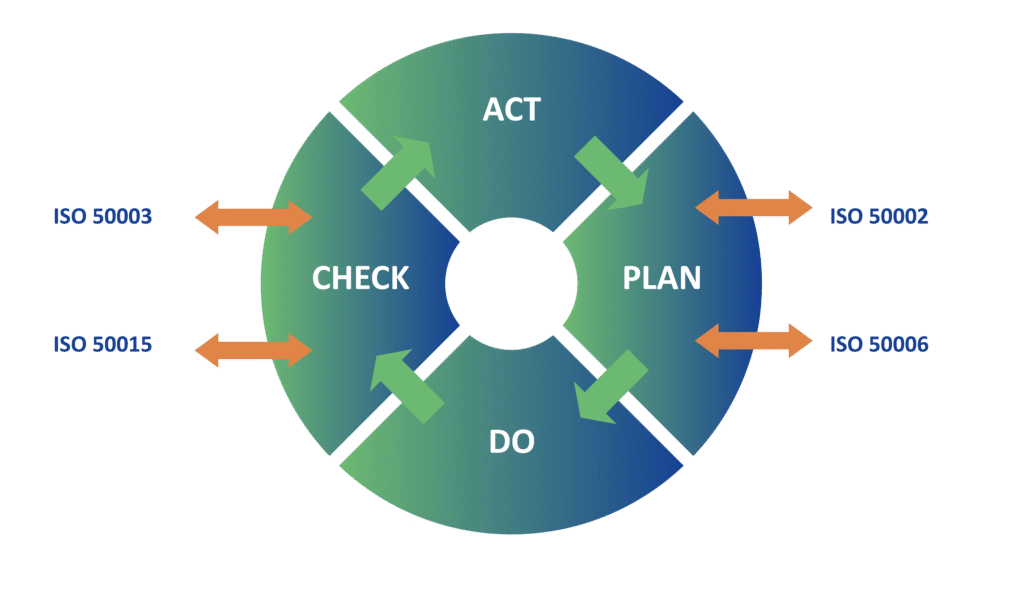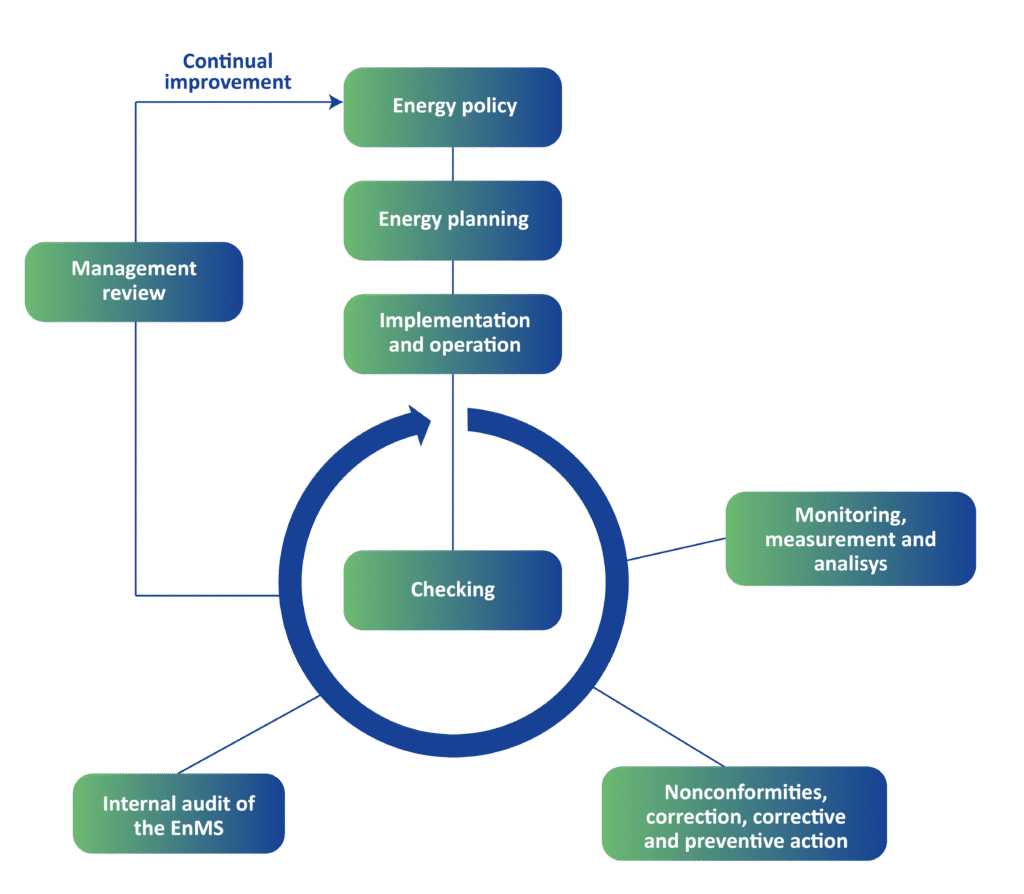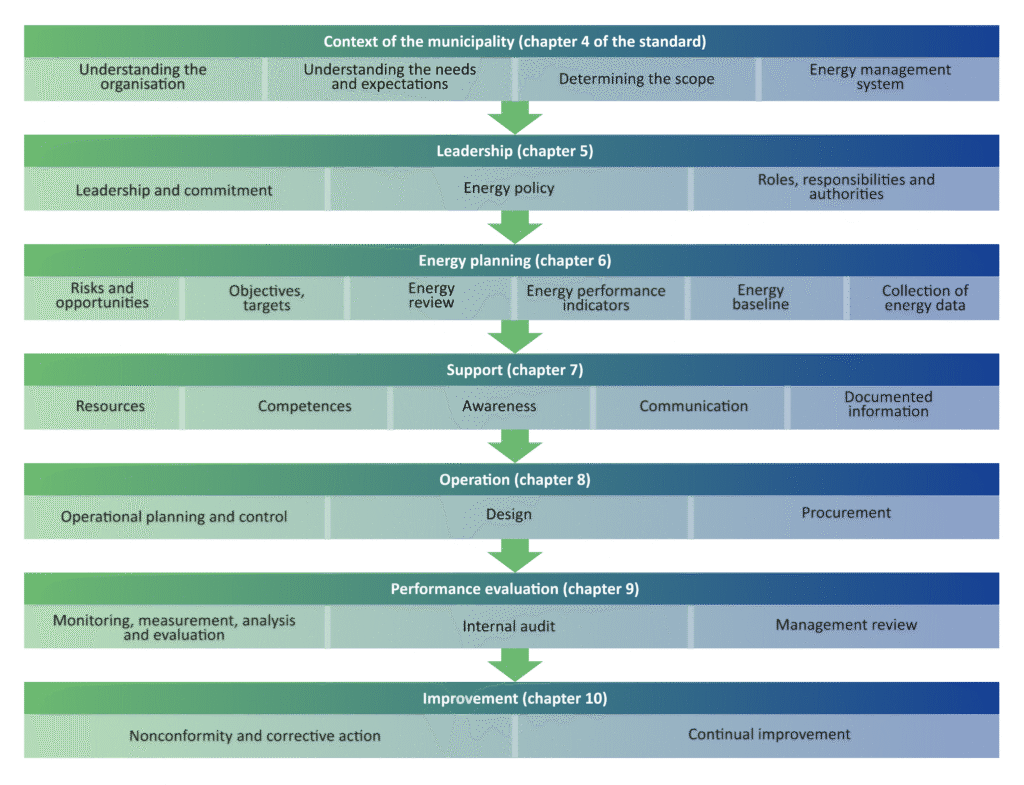Energy management system standards
Most of the countries and organizations developing EMS are using ISO 50001 standard. This standard specifies requirements for establishing, implementing, maintaining and improving an energy management system. In line with ISO 50001, energy management systems include regular energy reviews as part of the continuous plan-do-check-act improvement cycle. Although ISO 50001 does not explicitly reference ISO 50002 (energy audits), both ISO 50001 and ISO 50002 recognize that energy audits can support energy reviews and be part of energy management system. The ISO 50001 standard is structured according to the general Plan-Do-Check-Act (PDCA) approach. PDCA is an applied, iterative, four-step management method widely used by businesses for the control and continual improvement of their own processes and products.
- Plan: establish energy balances of the assets, as well as define necessary objectives, targets and action plans that will improve energy performance;
- Do: implement an effective energy management action plan;
- Check: provide a methodological and operational approach for monitoring and analysing the energy performance of the energy assets;
- Act: continually improve the energy performance with the aim that the EMS becomes not just a niche tool, but rather actually an integral part of the administration’s Energy Policy and day-to-day operations
 Figure 1: General framework of the ISO 50000 family [1]
Figure 1: General framework of the ISO 50000 family [1]
Energy audits or can function as stand-alone tools to assess the energy performance of public entities—such as governmental buildings or municipal facilities—and recommend improvements. In contrast, energy reviews are embedded within a continuous process of improving energy performance, requiring regular updates, typically conducted on an annual basis. The ISO 50001 standard is structured according to the general Plan-Do-Check-Act (PDCA) approach.
 Figure 2: Plan-Do-Check-Act (PDCA) approach for ISO 50001 standard
Figure 2: Plan-Do-Check-Act (PDCA) approach for ISO 50001 standard
Energy Management Systems, as defined by the ISO 50001 standard, offer a structured yet flexible framework for achieving continual improvement in energy performance. ISO 50001 is designed to accommodate organizational diversity by allowing each company and/or institution to tailor the implementation of the system to its specific operational context, resource availability, and strategic objectives. This built-in flexibility enables the EMS to function as integrated system – encompassing documented procedures, energy-related processes, personnel responsibilities, defined physical and organizational boundaries, and clearly established energy objectives and targets. Figure 3 illustrates the key components of ISO 50001:2019 for Energy Management Systems (EMS), structured according to the standard’s chapters and following the Plan-Do-Check-Act (PDCA) cycle.
- Context of the municipality and/or company (Chapter 4): Establishes the foundation by understanding the organization, its needs, and defining the EMS scope.
- Leadership (Chapter 5): Ensures top management commitment, energy policy development, and clear roles and responsibilities.
- Energy Planning (Chapter 6): Involves identifying risks and opportunities, setting objectives, reviewing energy use, and collecting data.
- Support (Chapter 7): Focuses on providing resources, building competencies, raising awareness, and ensuring effective communication.
- Operation (Chapter 8): Covers the implementation of energy plans, including design, control, and procurement activities.
- Performance Evaluation (Chapter 9): Includes monitoring, auditing, and reviewing performance to track progress and identify improvements.
- Improvement (Chapter 10): Addresses nonconformities and promotes continual improvement of the EMS.
 Figure 3: The main elements of ISO 50001:2019
Figure 3: The main elements of ISO 50001:2019
For public institutions, this continuous approach is critical for achieving long-term sustainability goals and reducing energy consumption across the public sector. The ISO 50001 is based on common elements found in many other ISO management system standards, which ensures a high level of compatibility with other ISOs you may already have in place, notably with ISO 9001 (Quality Management System) and ISO 14001 (Environmental Management System). Recommended to have a manual acting as the main document which describes its whole EMS process. In case if person changes or new employee arrives in the, the main rules are written down, shouldn’t be reinvented again and can be easily communicated. Then there are procedures which define in more details how a particular activity (e.g. the energy review) is actually achieved. This means in a practical sense that precise responsibilities, methodology and other aspects are already clearly established and approved beforehand. In several cases, additional templates and supporting documents are needed, including also databases (e.g. spreadsheets and/or monitoring tools as part of the EMS etc.).
[1] https://eur-lex.europa.eu/legal-content/EN/TXT/HTML/?uri=OJ:L_202402002